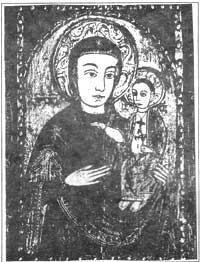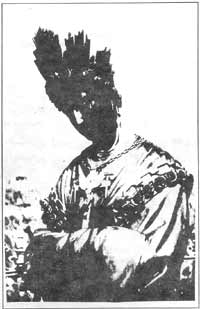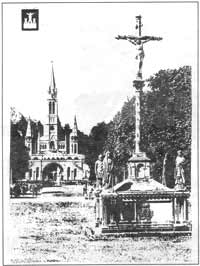A Marian Pilgrimage through Europe
The idea for our pilgrimage began when it was announced that the Society was organizing a pilgrimage for August 22, 1987. We thought, here is our chance—Fatima and the Mass. So we started to make plans to attend. Soon other seminarians thought they would like to go. But it ended up that only two of us were able to go. When we were discussing our plans, our spiritual directors suggested seeing other places in Europe since the cost of airfare is expensive, plus the actual pilgrimage at Fatima would not last long. We agreed that that was a good idea. So we decided to make a full Marian pilgrimage—fitting because of the Marian year.
We left for Europe on August 4th. We first traveled to Vienna, Austria, and we were welcomed by the priests of the Society at our priory there. The priests took us to the Cathedral of St. Stephen. There we were able to see the miraculous picture of Our Blessed Lady, Maria Potsch, that the Viennese had prayed before for the safety of Vienna when the Turks were besieging the city in 1683. The Turks had been besieging the city for 62 days. The Christian Alliance prepared for battle on September 8, the feast of the Nativity of Mary. The soldiers vowed to Our Lady that if they won they would solemnly celebrate the feast of the Immaculate Conception, December 8. On September 12, the soldiers attended the Mass of the Holy Name of Mary, and began battle on this day. They battled all day long. In the late afternoon the Turks fled. The Christians thought it was either a miracle or a trick of the Turks, so they stayed up all night waiting for the Turks to come back, but they never did. This is the reason the feast of the Holy Name of Mary was proclaimed a universal feast of the Church by Blessed Pope Innocent XI. From Vienna we went to Mariazelle. This is where the national Marian shrine of the Austrians, the Hungarians and the Slavs is located. This dates back to when all these nations comprised the Austro-Hungarian Empire, a Catholic empire. We were able to spend almost the whole day there praying. We were very glad to be able to pray at the tomb of Cardinal Mindszenty. Mariazelle has been a place of pilgrimage since the 1200's. But even before that it was a sanctuary of Our Lady.
|
|
We next went to Munich, Germany. Fr. Lehnen of the Society drove us to the national Marian shrine of Bavaria, Altoetting. The Society has a chapel there. Altoetting has been a place of pilgrimage since 1228. The statue venerated there was carved about 1330, by an unknown craftsman. Many of the rulers of Bavaria have had their hearts buried there, to show their devotion to Our Lady. During the time of the Reformation, there was a Bavarian Duke Maximillian I who was very devoted to Our Lady. After his death, his consecration to Our Lady was found, written in his own blood, under the statue of Our Lady, venerated there. Also there is buried in Altoetting, in a separate church, the body of General Tilly. He was a great leader in the fight against the Protestants during the Thirty Years War. He was in the army of Duke Maximillian I of Bavaria. He always went to Altoetting before and after a battle. He won thirty-two battles, and is considered one of the greatest generals of all times. He received from the Emperor the highest title of "General Lieutenant of the Imperial Armada." Something that really impressed us in the two shrines of the German-speaking area were the votive pictures that people would paint in thanks for the favor they had received from Our Lady. They are very simple and not masterpieces of art. They show the miracles, and give a short explanation.
The next Marian shrine we went to was Einsiedeln in Switzerland. Fr. Fellay, the Econome General of the Society, drove us there. Because we were in a hurry we were only able to spend about ten minutes there. This was an unexpected gift of Our Lady. We had never heard of Einsiedeln before Fr. Fellay mentioned it.
|
|
Up to then all the shrines we had visited were shrines graced by Our Lady with miracles. The shrines we next visited were built because of apparitions of Our Lady. The first shrine of apparitions that we visited were LaSalette, high up in the mountains of eastern France. Here it was that Our Lady appeared to two shepherds, Melanie and Maximin. Our Lady appeared there on September 19, 1846, to express her grief at the innumerable sins of men, especially against purity, those of blasphemy, and the violation of Sundays and Holy Days. She also gave to each of the children secrets which were transmitted to the saintly Pontiff, Pius IX. The secret foretold severe chastisements for the world and that Rome would lose the Faith and become the seat of Anti-christ.
After LaSalette we went to Lourdes. We had hoped to spend the whole day at Lourdes, and take the night train to Fatima. But the train to Fatima left at noon. One thing we noticed at Lourdes was that the atmosphere there was not really one of prayer. Lourdes seems to have become more of a tourist attraction—people walking around in shorts, looking around as if it was a type of amusement park, trying to see all the things that were there. They have already begun building a very modern new church to accommodate larger crowds, while they let the mosaics in the crypt chapel fall apart. It was good to see that the sick still come to Lourdes. At least there are some people who go to Lourdes with faith in Our Lady's intercession.
|
|
At Fatima it was a different story. The people acted like pilgrims. There was a spirit of prayer there. The people observed the standards of modesty. You could tell they came there for Our Lady. We finally arrived at Fatima on the morning of August 20. The train station was not anywhere near the town of Fatima, so we had to take a bus to get there. We had problems on the bus because they only took Portuguese money and all we had were French francs. Luckily there was a man on the bus who was with the Society who loaned us some of his Portuguese currency. The next problem was that the bus stopped at the market before it got to Fatima. The bus was then packed by women who had done their shopping and were laden with produce. As we neared the town, we wondered how we would find out where the Society priests were, and where the Mass would be. But Divine Providence was present, for when we go off the bus, right across the street was the field where the Society priests were setting up the tent for the Mass. We got settled in the hotel across the street from the field, and then volunteered our services to help with the preparations. As we were not needed we went to the shrine and prayed at the actual spot of the apparitions. I was given an envelope with petitions to be left at Fatima. I asked where it was that one left the petitions. I was told one could deposit them right under the statue where the apparitions took place. I was allowed by the guard to go right up to the actual spot of the apparitions and pray a bit. That first night we went to the night procession in the plaza. It began with a rosary, with each decade in a different language. Then the choir began the Fatima hymn and the statue of Our Lady of Fatima was carried out of the sanctuary where the apparitions actually took place. The pilgrims would follow a cross with their lit candles and singing the Fatima hymn. We were embarrassed while we were there because during the rosary, people would recognize the cassock, and come over and ask when and where the Mass would be tomorrow, the twenty-first of August, and there were people telling us to be quiet. On the 21st, we spent the morning serving Mass for the different Society priests who had come for the pilgrimage. In the afternoon we went to the shrine to pray some more. We were able to pray at the tombs of Francisco and Jacinta, who we hope will be canonized during the next trip of the Pope to Fatima, this fall.
The actual Society pilgrimage began at 5:00 p.m. with the Stations of the Cross led by Father Schmidberger and then a Solemn Mass of Our Lady of Sorrows, celebrated by Father Williamson. The Blessed Sacrament was then exposed for all-night adoration. We prayed the rosary, and sang hymns until 9:00 p.m. when Father Aulagnier celebrated a Solemn High Mass in honor of Saint Pius X. Exposition began again, and the pilgrims from France went to the sanctuary. When they returned, the German and English pilgrims went to the sanctuary. At midnight, Father Schmidberger celebrated a Solemn High Mass of the Immaculate Heart of Mary. Adoration continued until the next morning at 7:00. There was then a Mass for people to go to communion, so there would not be too large of a crowd for communion at 9:00 a.m.
|
|
The Pontifical High Mass began at 9:00 a.m. In his sermon the Archbishop spoke of Our Lady's Immaculate Heart, the miracle of the sun, and the various things that occurred during the miracle of the sun. He spoke of how we should obey Our Lady's requests, and pray the rosary. He spoke of the secret, that it was supposed to be revealed in 1960, but that Rome is keeping it from us, probably because it contains information about the crisis the Church is now going through. "We must pray," he said.
After the Mass, we helped to take down the altar, and I went to serve Fr. Richard Williamson's Mass. That night we went for the candle-light procession in the plaza. We went with the Swiss pilgrims before the event, and then we all joined the French pilgrims when it began. After the procession we got as close as possible to the apparition site and renewed our consecration to Our Lady according to the method of St. Louis de Montfort.
On Sunday we attended the Mass of the Spanish pilgrims, and rode with them to Madrid to catch our flight home the following day.
As you can see we were able to see the intervention of Our Lady throughout history in this pilgrimage. We first saw Our Lady rewarding the people's devotion by granting miracles to take place at the sanctuaries dedicated to her. We saw the miracles she worked when the Christians joined together in prayer to storm heaven for victory over the Turks and the Protestants. But then the faith of people grew cold. Our Lady began appearing to warn us of the chastisements that would be ours if we did not convert back to God. She came to us: at Lourdes, at LaSalette, Rue du Bac, Knock, Beauraing, Banneux and, finally, at Fatima. Our Lord told Sister Lucy that this is the last devotion He is giving to the world—devotion to the Immaculate Heart of Mary. We must do what she asked at Fatima: pray the rosary, make sacrifices in our daily lives. We must make the message known more. Surely it is known by most all of the traditionalists, but do we live it? We must also make it known to our Novus Ordo friends and family, and especially to the bishops who are supposed to consecrate Russia with the Pope to the Immaculate Heart of Mary. If not, Russia will be the instrument of God in chastising the rest of the world.




